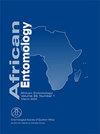Developments and Prospects for Biological Control of Prosopis (Leguminosae) in South Africa
IF 1.2
4区 农林科学
Q3 ENTOMOLOGY
引用次数: 6
Abstract
South Africa was the first country to deploy biological control (biocontrol) against invasive Prosopis populations. Developments in this regard have been ongoing, and have been reviewed, at approximately 10-year intervals, since 1991. This review spans the period 2011-2020, a timespan globally characterised by increased awareness of the impacts of invasive Prosopis populations, and recognition of the need for improved management. Concerted international collaboration has resulted in enhanced clarity on phylogenetic relationships within the Leguminosae and the phylogenetic placement of Prosopis. These advances have improved the framework for interpreting the host range of potential agents and for evaluating risk. At the outset of the biocontrol programme, in the 1980s, only agents that consumed mature seeds were considered. The intention was to reduce the invasiveness of Prosopis while simultaneously retaining it as a usable resource. The programme was subsequently expanded to investigate agents that prevent pod set or maturation of seed. More recently, potential agents that damage the vegetative growth of the plants have been included in response to recognition in South Africa, that there is no other route to successful management of Prosopis. There is a wealth of largely unexplored potential in this regard.南非Prosopis(豆科)生物防治的发展与展望
南非是第一个对入侵的Prosopis种群进行生物控制的国家。自1991年以来,这方面的发展一直在进行,并每隔大约10年进行一次审查。这项审查跨越了2011-2020年,这是一个全球范围内的时间跨度,其特点是提高了对入侵Prosopis人群影响的认识,并认识到需要改进管理。协调一致的国际合作使豆科植物的系统发育关系和Prosopis的系统发育位置更加清晰。这些进展改进了解释潜在病原体宿主范围和评估风险的框架。在20世纪80年代生物防治方案开始时,只考虑使用消耗成熟种子的药剂。其目的是减少普罗索皮斯的入侵性,同时将其保留为可用资源。该项目随后扩大到研究阻止种子结荚或成熟的药剂。最近,南非认识到,没有其他途径可以成功管理Prosopis,因此纳入了破坏植物营养生长的潜在制剂。在这方面有大量尚未开发的潜力。
本文章由计算机程序翻译,如有差异,请以英文原文为准。
求助全文
约1分钟内获得全文
求助全文
来源期刊

African Entomology
生物-昆虫学
CiteScore
2.00
自引率
0.00%
发文量
17
审稿时长
6-12 weeks
期刊介绍:
African Entomology (ISSN 1021-3589 – print / 2224-8854 – online) replaced the old Journal of the Entomological Society of Southern Africa in 1993. A single volume consisting of two issues (March and September) is published annually. The journal is indexed in all major abstracting journals
African Entomology is a peer reviewed scientific journal that publishes original research articles and short communications on all aspects of entomology, with an emphasis on the advancement of entomology on the African continent.
 求助内容:
求助内容: 应助结果提醒方式:
应助结果提醒方式:


